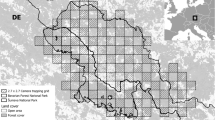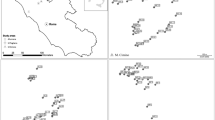Abstract
A 3-year live trapping investigation was carried out in a temperate forest in central Tlaxcala, México from 2002 to 2004. During a total of 504 trap nights, 87Silvilagus cunicularius Waterhouse, 1848 individuals were captured and marked, and age-specific survival models using demographic parameters were tested using the JOLLYAGE program. We evaluated population density of this species over a 1-year period. The age structure of the population varied among years, and the proportion of adults was relatively constant among years, whereas the proportion of juvenile showed high fluctuations. The sex ratio of juveniles that were recaptured as adults, did not differ from unity neither did the sex ratio for adults. We found no sex bias among cottontails during all 3 years of the study. When data for both sexes were combined, mean survival probability of juveniles was lower than that of adults. Although our line transect counts showed a mean density of 27 ± 5.4 individuals per km2, the obtained results from trapping suggests that this species is low in abundance at La Malinche. Further studies are needed to evaluate demographical aspects of this species at different protected and unprotected areas to obtain robust information about their status.
Similar content being viewed by others
References
Alvarado A. D. 1983. Anatomía comparada del complejo gomacetérico enRomerolagus diazi, Sylvilagus floridanus y Sylvilagus cunicularius cunicularius. B.S. thesis, Universidad Nacional Autónoma de México, México, Distrito Federal: 1–70.
Alvarez T., Arroyo-Cabrales J. and González-Escamilla M. 1987. Mamíferos (excepto Chiroptera) de la Costa de Michoacán, México. Anales de la Escuela Nacional de Ciencias Biológicas 31: 13–62.
Aranda J. M. S., Martínez del Río C. M., Colmenero L. C. R. and Magallon V. M. S. 1980. Los mamíferos de la Sierra del Ajusco. Comisión coordinadora para el desarrollo agropecuario del departamento del distrito federal, Ciudad de México: 1–145.
Armstrong D. M. and Jones J. K. 1971. Mammals from the Mexican state of Sinaloa. I Marsupalia, Insectivora, Edentata, Lagomorpha. Journal of Mammalogy 52: 747–757.
Boag B. 1992. Observations on the variation in the sex ratio of wild rabbits (Oryctolagus cuniculus) in eastern Scotland. Journal of Zoology, London 227: 338–342.
Bond B. T., Burger L. W. Jr and Leopold B. 2001. Survival of cottontails (Sylvilagus floridanus) in Mississippi and an examination of latitudinal variation. American Midland Naturalists 145: 127–136.
Boyd I. L. and Myhill D. G. 1987. Seasonal changes in condition, reproduction and fecundity in the wild European rabbit (Oryctolagus cuniculus). Journal of Zoology, London 212: 223–233.
Buckland S. T., Anderson D. R., Burnham K. P. and Laake J. L. 1999. Distance sampling: estimating abundance of biological populations. Chapman and Hall, London: 1–446.
Ceballos G. G. and Galindo C. L. 1984. Mamíferos silvestres de la Cuenca de México. Limusa, México, Distrito Federal: 1–299.
Ceballos G. G. and Miranda A. 1986. Los mamíferos de Chamela, Jalisco. Instituto de Biología. Universidad Nacional Autónoma de México, México, Distrito Federal: 1–464.
Cervantes F. A., Lorenzo C., Vargas J. and Colmes T. 1992.Sylvilagus cunicularius. Mammalian Species 412: 1–4.
Cervantes F. A. 1993. Conejos y liebres de México. Ciencia y Desarrollo 10: 58–96.
Cervantes F. A. and González F. 1996. Los conejos y liebres silvestres de México. [In: A. Velázquez, F. J. Romero and J. A. Paniagua, eds]. Ecología y conservación del conejo zacatuche y su hábitat. Fondo de cultura económica. Universidad Nacional Autónoma de México: 17–25.
Chapman J. A. and Ceballos G. G. 1990. The cottontails. [In: Rabbits, hares and pikas-status survey and conservation action plan. J. A. Chapman and J. E. Flux, eds]. IUCN/SSC, Gland, Switzerland: 95–110.
Davis W. B. 1944. Notes on Mexican mammals. Journal of Mammalogy 35: 370–403.
Davis W. B. and Lukens P. W. 1958. Mammals of the Mexican state of Guerrero, exclusive of Chiroptera and Rodentia. Journal of Mammalogy 39: 347–367.
Davis W. B. and Russell R. J. 1954. Mammals of the Mexican state of Morelos. Journal of Mammalogy 35: 63–80.
Diersing V. E. and Wilson D. E. 1980. Distribution and systematics of the rabbits (Sylvilagus) of west-central Mexico. Smithsonian Contributions of Zoology 297:1–34.
Gibb J. A., Ward G. D. and Ward C. P. 1969. An experiment in the control of a sparse population of wild rabbits (Oryctolagus cuniculus) in New Zealand. New Zealand Journal of Sciences 227: 338–342.
Hall E. R. 1981. The mammals of North America. Vol. 1. Ronald Press, New York: 1–00.
Hoth J., Velázquez A., Romero F. J., León L., Aranda M. and Bell D. 1987. The volcano rabbit, a shrinking distribution and a threatened habitat. Oryx 21: 85–91.
Hudson R., Rodríguez-Martínez L., Distel H., Cordero C., Altbacker V. and Martínez M. 2005. A comparison between vegetation and diet records from the wet and dry season in the cottontail rabbitSylvilagus floridanus at Ixtacuixtla, central Mexico. Acta Theriologica 50: 377–389.
IUCN (International Union for Conservation of Nature and Natural Resources). 2004. 2004 IUCN Red List of Threatened Species. www.redlist.org. Downloaded on 14, March 2005.
Kolb H. H. 1993. Analysis of cage trapping for rabbit control on a Scottish hill farm. Crop Protection 12: 106–110.
Laake T. L., Strindberg S. J. L., Marques F. C., Buckland S. T., Borchers D. L., Anderson D. R., Burnham K. P., Hedley S. L. and Pollard J. H. 2002. Distance 4.0. release “1” research unit for wildlife population assessment, University of St. Andrews.
Lebreton J. D., Burnham K. P., Clobert J. and Anderson D. R. 1992. Modeling survival and testing biological hypotheses using marked animals: a unified approach with case studies. Ecological Monographs 62: 67–118.
Martínez J. G. 1990. Utilización del conteo nocturno en la estimación de la densidad poblacional de algunos mamíferos silvestres en el sureste de Linares, N.L., México. B.S. thesis, Universidad Autónoma de Nuevo León. Monterrey, Nuevo León, México: 1–43.
Pollock K. H. 1981. Capture-recapture models allowing for age-dependent survival and capture rates. Biometrics 37: 521–529
Pollock K. H., Nichols H. J. D., Brownie C. and Hinez J. E. 1990. Statistical inference for capture-recapture experiments. Wildlife Monographs 107: 1–97.
Ramírez-Pulido J., Martínez A. and Urbano G. 1977. Mamíferos de la Costa Grande de Guerrero. Anales del Instituto de Biología, UNAM, Serie Zoológica 48: 243–292.
Rodríguez M. L. 2004. Estacionalidad reproductora del conejo montés (Sylvilagus cunicularius) en el Parque Nacional La Malinche. MSc thesis, Universidad Veracruzana. Xalapa, Veracruz, Mexico: 1–52.
Sántiz E. L. 2002. Distribución y abundancia de la liebre endémicaLepus flavigularis y el conejo castellanoSylvilagus floridanus (Mammalia: Leporidae) en el Istmo de Tehuantepec, Oaxaca, Mexico. B.S. thesis, Universidad de Ciencias y Artes de Chiapas. Tuxtla Gutierrez, Chiapas, Mexico: 1–70.
Smith G. W. and Nydegger N. C. 1985. A spotlight, line-transect method for surveying jack rabbits. The Journal of Wildlife Management 49: 699–702.
Smith G. C., Pugh B. and Trout R. C. 1995. Age and sex bias in samples of wild rabbits,Oryctolagus cuniculus, from wild populations in southern England. New Zealand Journal of Zoology 22: 115–121.
Vaughan T. A. 1985. Mammalogy. Saunders College Publishers, Philadelphia: 1–576.
Vázquez J. 2005. Carga de parásitos y su relación con el estado fisiológico del conejo endémico de MéxicoSylvilagus cunicularius. MSc thesis, Universidad Veracruzana. Xalapa, Veracruz. Mexico: 1–56.
Velázquez A. 1994. Distribution and population size ofRomerolagus diazi on el Pelado Volcano, Mexico. Journal of Mammalogy 75: 743–749.
Zar J. H. 1999. Biostatistical analysis. Fourth Edition. Prentice Hall, Inc.: 1–663.
Author information
Authors and Affiliations
Corresponding author
Additional information
Associate editor was Joseph F. Merritt
Rights and permissions
About this article
Cite this article
González, J., Lara, C., Vázquez, J. et al. Demography, density, and survival of an endemic and near threatened cottontailSylvilagus cunicularius in central Mexico. Acta Theriol 52, 299–305 (2007). https://doi.org/10.1007/BF03194226
Received:
Accepted:
Issue Date:
DOI: https://doi.org/10.1007/BF03194226




